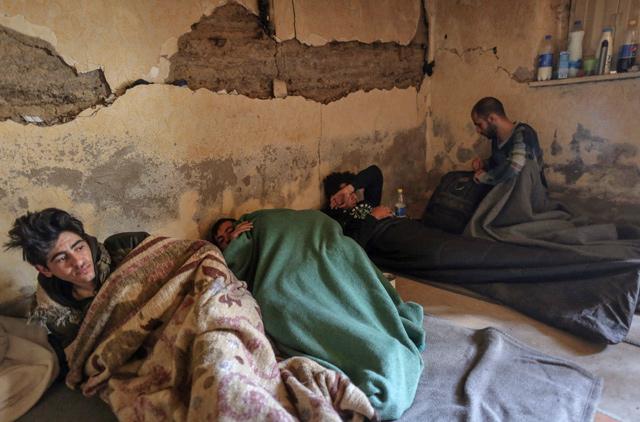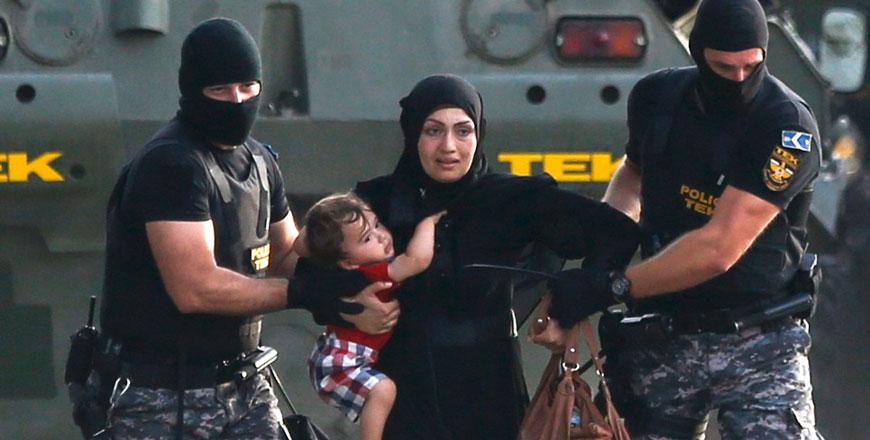You are here
‘Poor people’s route’: Why migrants are heading for Romania
May 29,2021 - Last updated at May 29,2021

A group of migrants sleep in a derelict house in Serbian village Majdan, close to the Hungary and Romania borders, on May 21 (AFP photo)
By Miodrag Sovilj
Agence France-Presse
MAJDAN, Serbia — Inside an abandoned house, onions sizzle as mother-of-four Seror struggles to cook an Iraqi speciality over an open fire, trying to maintain an illusion of home for her loved ones.
The Alhayani family are among hundreds of people from the Middle East, Africa and Asia sheltering in derelict houses in Serbian villages close to the Hungary and Romania borders.
Most are trying to get to Western Europe via Romania, a new hotspot on the Balkan migrant route where arrival numbers have been rising rapidly in the past two years.
Romania was not hugely affected by the 2015 migrant crisis, when tens of thousands went directly from Serbia to Hungary and beyond.
But the frontier is regarded as easier to negotiate than the entry points into Croatia, which has a reputation for harsh policing, and Hungary, which built a razor-wire fence as a deterrent in 2015.
As they wait for their chance to move on, the Alhayanis occupy a house abandoned decades ago by the original residents, who left looking for a better life.
They sleep on the ground where damp has consumed the parquet, in constant fear that the ancient roof might collapse.
“Of course, this is not a dream house, but what can we do?” asks their 16-year-old daughter, the only member of her family to have learnt English during their journey.
“We must stay here to be able to fulfil our dreams in the future.”
‘They broke my leg’
The Alhayani family fled Iraq three years ago and, after spending two years in a camp in Greece, tried in vain to get into Croatia via Bosnia.
They finally arrived in Majdan in northern Serbia a month ago, trying to cross into Romania every day with no success.
The Romania path might be easier but it is a “poor people’s route”, said a group of Syrians crowded into one small room, getting ready to try to cross the border one more time.
For those who have run out of money, crossing into Romania is virtually the only option.
But it makes their trip longer and harder, and only delays the inevitable journey through Hungary, which is the first country in Europe’s passport-free Schengen area.
“If I had 5,000 or 6,000 euros [$6,100 or $7,300], I would pay [a smuggler] to go directly from Serbia to Hungary,” a 30-year old Syrian man, who declined to be named, told AFP.
Romanian police said there were more than 45,000 attempts to “illegally cross the border” last year, four times more than in 2019.
They say almost 80 per cent of the migrants were refused entry.
Romanian police once had a better reputation than their colleagues in Hungary and Croatia, but now they are also accused of violence and international law violations.
“Romanian police broke my leg two times, and my hand once,” a Syrian migrant, who said he worked as a lawyer in his home country, told AFP.
“Some people are good, some are bad.”
The UN refugee agency’s Ljubimka Mitrovic told AFP that more than 25,000 migrants said they had been pushed back across the Romanian border in 2020, more than double the figure from the previous year.
Pointing out that pushbacks — forced expulsions without the chance to apply for asylum — are illegal, she said 12 per cent of those pushed back by Romania had suffered violence.
Contacted several times by AFP for a response to the allegations, Romanian police did not reply.
They have previously denied violent pushbacks, as have the Croatian and Hungarian forces.
‘You can’t stop people’
Trapped in Serbia, the migrants do not get a warm welcome in a largely Hungarian speaking border area.
Many locals are older farmers who get their information from Hungarian national media, known for its anti-immigration tone.
“Life will be good again when these migrants leave, they are like rats,” said an older man with an army tattoo on his shoulder.
Locals sitting outside the only local shop boo and curse when migrants come in.
Police patrol around the clock to prevent potential violence between the two groups.
“We have offered to build a camp there, but the local community declined,” Vladimir Cucic, head of Serbia’s refugee agency, told AFP.
“They didn’t want to become a refugee hub.”
Although the so-called Balkan route is nowhere near as busy as it was during Europe’s migrant crisis five years ago, tens of thousands still cross the region every year.
Cucic expects another surge very soon.
“It’s like trying to hold water. You can’t stop people,” he said.
Related Articles
SID, Serbia/ROSZKE, Hungary — Riot police fired water cannon and tear gas on Wednesday at migrants demanding to be let through Hungary's new
SERBIAN-HUNGARIAN BORDER — Asylum seekers clamouring to enter the European Union were turned back at a razor-wire fence on the Hungarian bor
BELGRADE — Driven back by police batons and snarling dogs, or beaten and robbed by the smugglers they relied on, migrants caught in Serbia h














